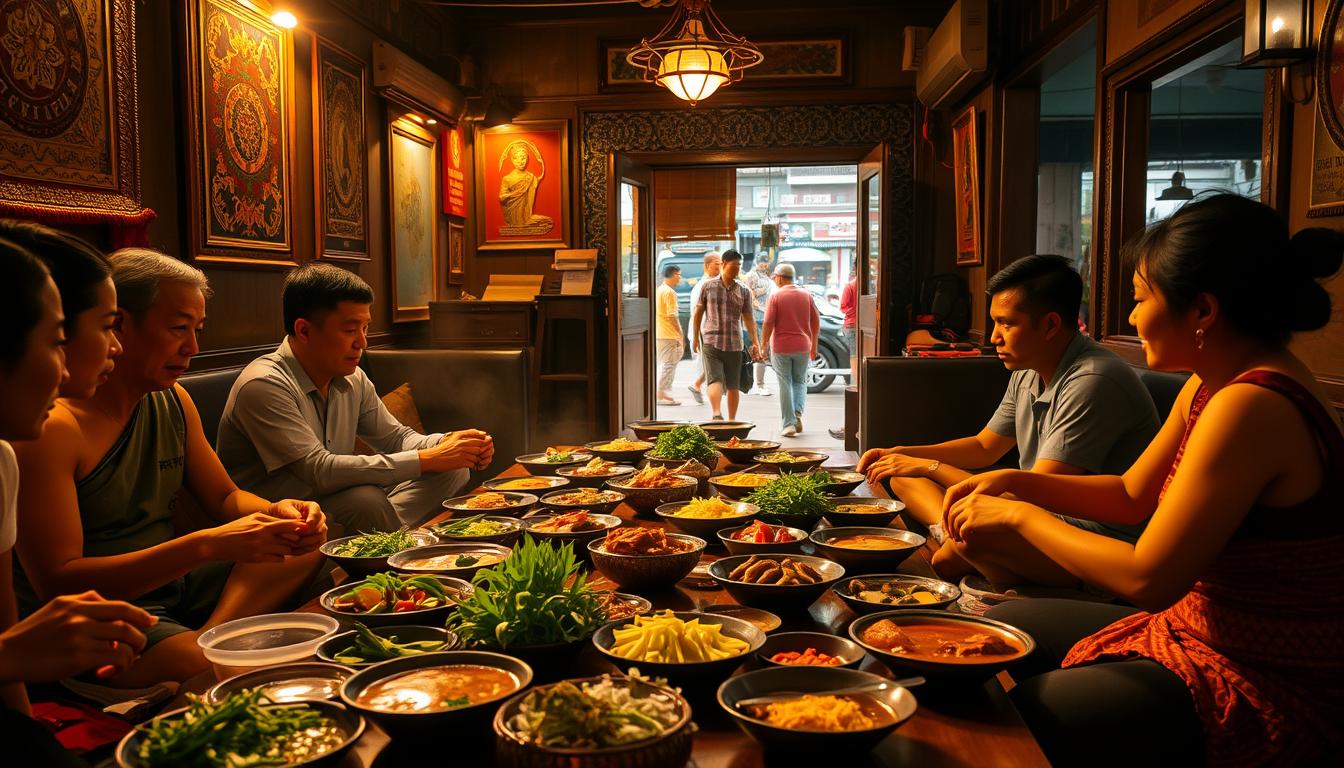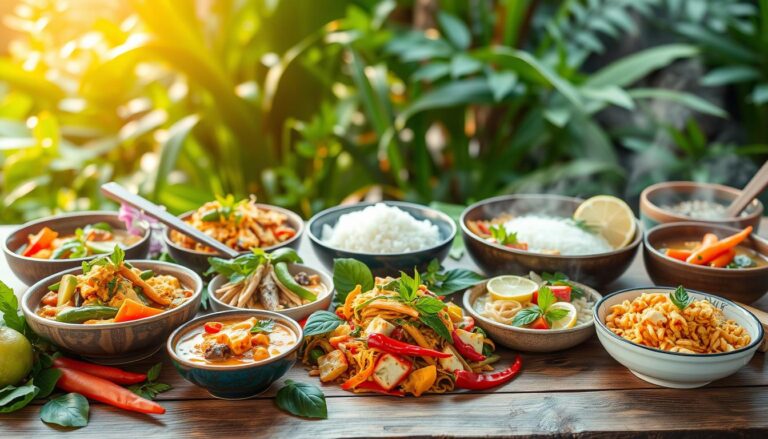Thai Dining Etiquette: Eat Like a Local Guide
In Thailand, mealtimes are more than just eating. They’re a chance to connect with family and friends. Sharing food shows respect and community values.
Exploring Thai culture means learning about local customs. When you eat, you join a tradition that’s part of Thai heritage. It’s not just about food.
To truly enjoy dining like a local, you need to know the basics. This guide covers everything from using utensils to table manners. It ensures your dining is both fun and respectful.
Understanding Thai Culture and Cuisine
Food is very important in Thai culture. It brings people together. In Thailand, eating is more than just food; it’s about culture, tradition, and community.
Dining in Thailand is a cultural ritual. It’s not just about eating. It’s about bonding with family and friends. This shows the value of unity and respect in Thai customs.
The Importance of Sharing Meals
Sharing meals is key in Thai culture. It shows unity and respect. When you eat in Thailand, meals are shared in a communal style.
- This communal style of dining strengthens bonds among family and friends.
- It also shows Thai values of generosity and hospitality.
- Sharing food shows respect and builds community.

Symbolism in Thai Food
Thai cuisine is full of symbolism. Certain dishes and ingredients hold deep cultural meaning. For example, fresh herbs and spices add flavor and symbolize freshness and vitality.
Some key symbols in Thai food include:
- The balance of sweet, sour, salty, and spicy flavors represents harmony and balance in Thai culture.
- Certain ingredients, like chilies, symbolize the fiery passion and energy of the Thai people.
- The way dishes are presented reflects Thai aesthetic values, showing beauty and attention to detail.
Understanding these symbols can make you appreciate Thai cuisine more. It can also make your dining experience in Thailand richer.
Table Settings and Dining Arrangements
To fully enjoy Thai cuisine, understanding traditional table settings is key. In Thailand, meals are more than just food. They’re about sharing moments and bonding with others.
Traditional Thai Table Layout
A traditional Thai table has dishes in the center for everyone to share. Each person gets their own plate for rice and sometimes soup. This way of eating brings people together, showing the heart of Thai culture.
Dishes are placed in the middle for easy access, making meals a time for community. You’ll see a variety of dishes, like curries and stir-fries, on the table. They offer different tastes and textures.
The Role of the Host
The host is very important in Thai dining. They prepare the meal and arrange the dishes nicely. This makes sure guests are comfortable and happy.
A good host also makes sure everyone has enough to drink and eat. This shows Thai hospitality, making guests feel special and welcome.
The key to a successful Thai dining experience lies in the balance between the dishes and the company.
Eating Utensils and Their Use
To fully immerse yourself in Thai culture, it’s essential to know how to use eating utensils correctly. Understanding the proper use of utensils in Thai dining is key for a respectful and enjoyable experience.
Chopsticks, Spoons, and Forks
In Thailand, the primary utensils used are a spoon and fork, with the spoon being the main utensil for eating. The fork is used to push food onto the spoon. Chopsticks are typically reserved for specific dishes like noodle soups. When using chopsticks, it’s essential to hold them correctly and avoid standing them upright in your rice, as this is reminiscent of a funeral ritual.
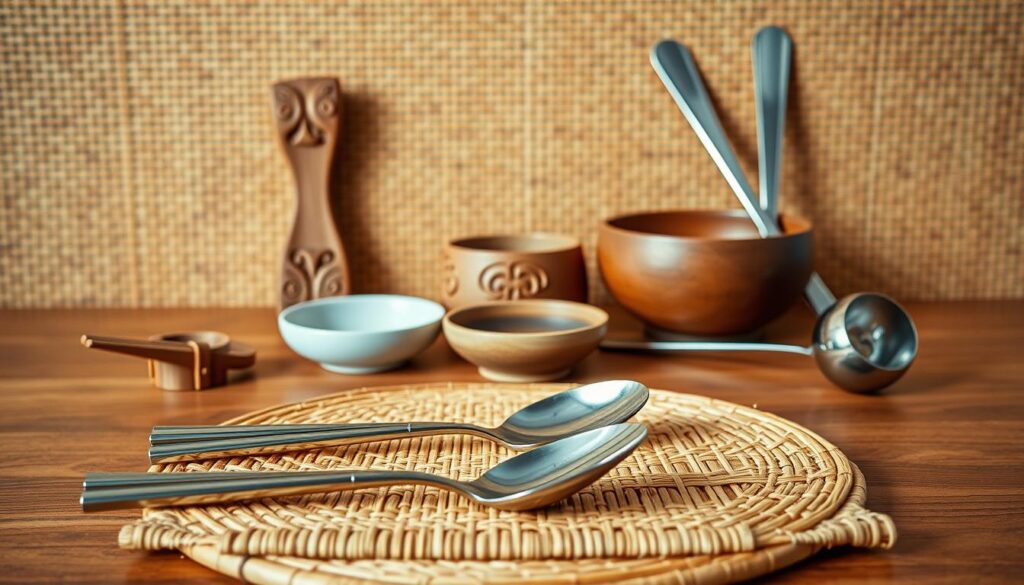
When to Use Your Hands
While utensils are the norm, there are times when using your hands is acceptable and even preferred. For example, when eating sticky rice or certain types of street food, using your hands is part of the local custom. It’s essential to be mindful of your hands’ cleanliness and to follow the lead of your hosts or other diners. Using your hands can be a way to connect with the food and the people you’re dining with, making your experience more enjoyable and meaningful.
By understanding when to use utensils and when to use your hands, you’ll be able to navigate Thai dining with confidence and respect. This knowledge is a key part of etiquette tips that will help you show respect in Thai dining, making your experience more enjoyable and meaningful.
The Order of Service
When dining Thai style, knowing the order of service is key for a great time. Thai meals are full of variety and complexity. They often have several dishes served together, which can be confusing for newcomers.
Appetisers, Main Courses, and Desserts
In a traditional Thai meal, it’s hard to tell where appetisers, main courses, and desserts start and end. Several dishes, like curries, stir-fries, and soups, are put on the table at once. You can start with the dishes that catch your eye first.
- Common appetisers include fried insects or som tam (papaya salad).
- Main courses often feature a variety of curries and stir-fries.
- Desserts like khao niew (sticky rice with mango) are usually served alongside other dishes.
Timing Your Courses
The timing of your courses is flexible, allowing you to enjoy your meal at your own pace. It’s customary to try a bit of everything before focusing on particular dishes. You should:
- Begin with a small amount of each dish to sample the various flavours.
- Return to your favourites as you see fit.
- Keep in mind that Thai meals are meant to be shared, so don’t be shy to try a little of everything.
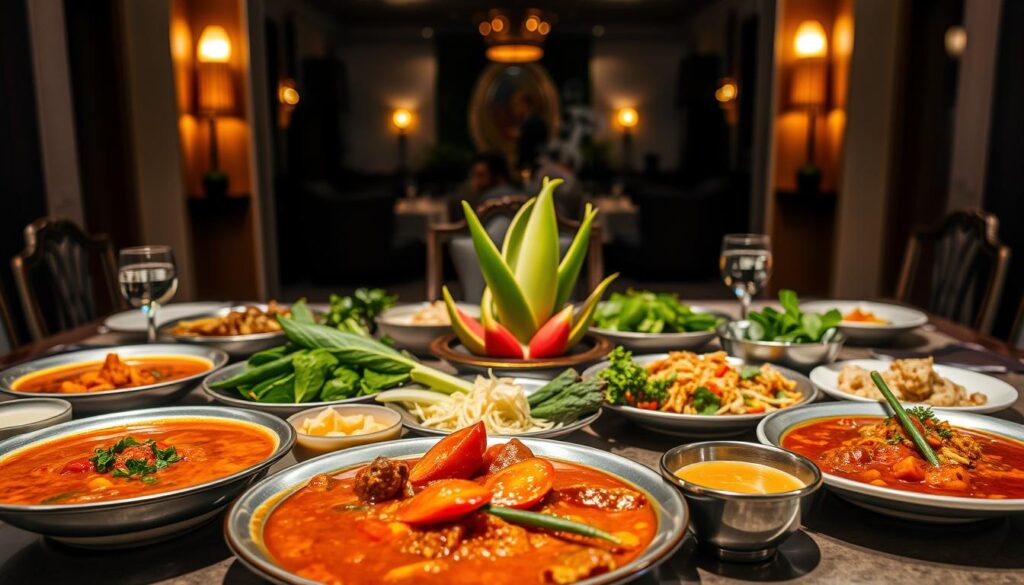
Understanding the order of service in Thai dining etiquette makes you appreciate the meal more. By knowing how to navigate the various dishes and timing your courses right, you can fully enjoy the Thai dining experience.
The Role of Flavours in Thai Cuisine
Thai cooking is all about finding the right mix of sweet, sour, salty, and spicy. This mix shows the importance of balance in Thai culture.
Balancing Sweet, Sour, Salty, and Spicy
Thai dishes are famous for their rich flavours. This comes from mixing different ingredients carefully. The secret is using:
- Sweet things like palm sugar and fruits
- Sour bits like tamarind and lime juice
- Salty tastes from fish sauce and salt
- Spicy chillies and spices
This mix of flavours is not just about taste. It’s about creating a harmonious meal that shows Thai culture and traditions.
Importance of Fresh Ingredients
Fresh ingredients are key in Thai cooking. They help create the complex flavours and smells of Thai dishes. Using fresh ingredients keeps the flavours balanced, making the dishes lively and fragrant.

How to Handle Food Etiquette
To truly immerse yourself in Thai culture, mastering the art of food etiquette is essential. When dining in Thailand, you’re not just eating a meal. You’re participating in a cultural experience that is deeply rooted in tradition and respect.
Respecting Personal Space
When dining with Thais, it’s important to respect the personal space of others at the table. This means not stretching across the table to grab something. Instead, wait for dishes to be passed to you or politely ask for them to be passed. By doing so, you show consideration for others and adhere to proper table manners in Thailand.
Avoiding Food Waste
Another important aspect of Thai dining etiquette is avoiding food waste. Thais take great pride in their cuisine, and wasting food is considered disrespectful. You should try a little of everything served and eat what you can, showing appreciation for the meal prepared. This practice not only reflects good manners but also enhances your dining in Thailand experience.
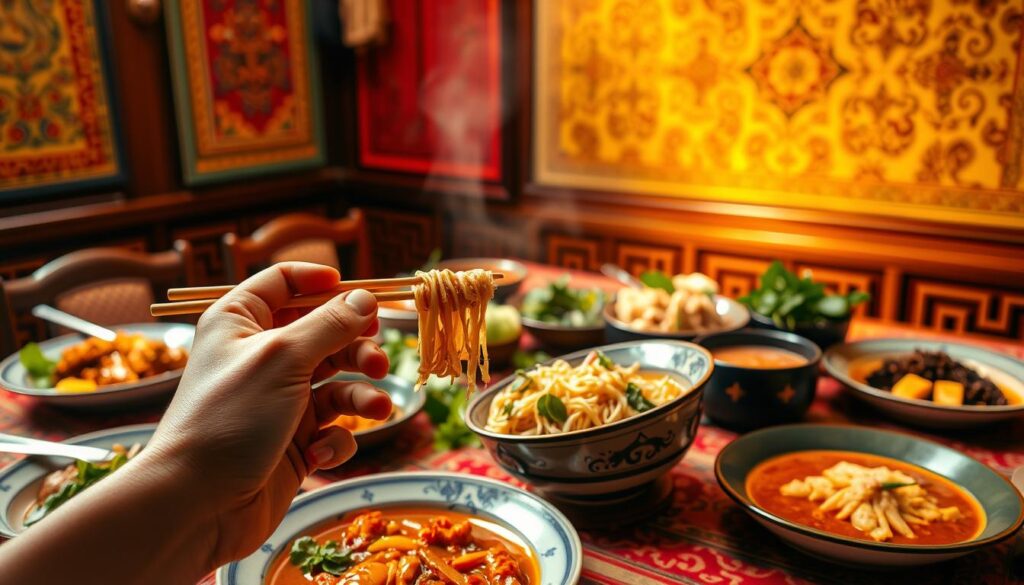
Greetings and Farewells at the Table
When you sit down for a Thai meal, knowing the traditional greetings and thanks can make it better. In Thai culture, how you greet and say goodbye is key to dining etiquette.
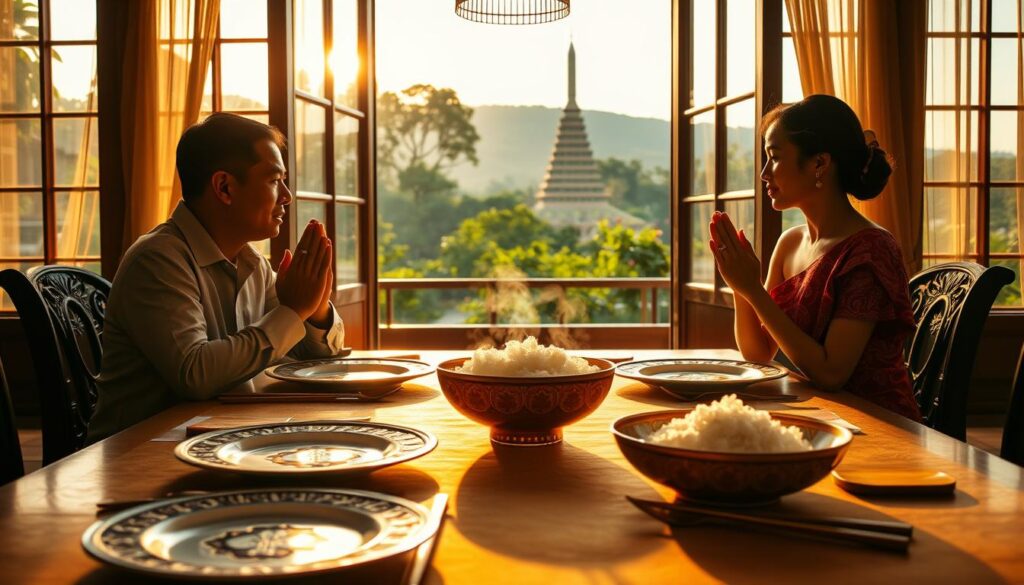
Traditional Thai Greetings
In Thailand, the traditional greeting is called the “wai.” You place your palms together at chest level and bow slightly. The “wai” shows respect to hosts, elders, and others at the table.
The higher your hands and the deeper your bow, the more respect you show. To respond to a “wai,” mirror the gesture. If unsure, a smile and nod are polite.
Expressing Gratitude
It’s polite to thank your hosts for the meal. Say “khop khun krap” (thank you). This shows you value the effort in preparing the meal.
When you’ve finished, leave a bit of food on your plate. This means you’ve had enough to eat. It’s a way to thank your hosts for the meal.
By using traditional Thai greetings and thanks, you show respect for the culture and company. This makes your dining experience better.
Communal Dining Practices
Communal dining is key in Thai meals, where respect and community matter a lot. In Thailand, meals are more than just food; they’re about sharing and bonding with others.

Dishes to Share
Thai meals usually have several dishes served family-style. This encourages everyone to share and try a bit of everything. It shows the importance of Thai meal traditions, focusing on community and togetherness.
When dining, you’ll find a variety of dishes, like curries, stir-fries, and soups. It’s important to know which dishes are meant to be shared. Most Thai meals include a mix of dishes for everyone to enjoy. This includes curries, noodle dishes, and vegetable stir-fries.
Passing Food Politely
Sharing food politely is key in Thai culture. Respect in Thai dining is shown by serving others. When passing dishes, use your serving spoon to serve a portion onto your neighbor’s plate. Or pass the dish in a way that lets others serve themselves.
- Always use your serving spoon to serve others.
- Pass dishes to your right to follow the traditional flow.
- Be mindful of the dishes you’re passing and ensure they’re not too hot or messy.
By following these simple practices, you’ll fully join in Thai communal dining. You’ll show respect for the culture and the people you’re dining with.
Appropriate Behaviour During Meals
To fully immerse yourself in Thai dining culture, it’s essential to be mindful of your behaviour during meals. Thai mealtimes are characterised by a sense of community and respect. The atmosphere is generally relaxed and friendly.
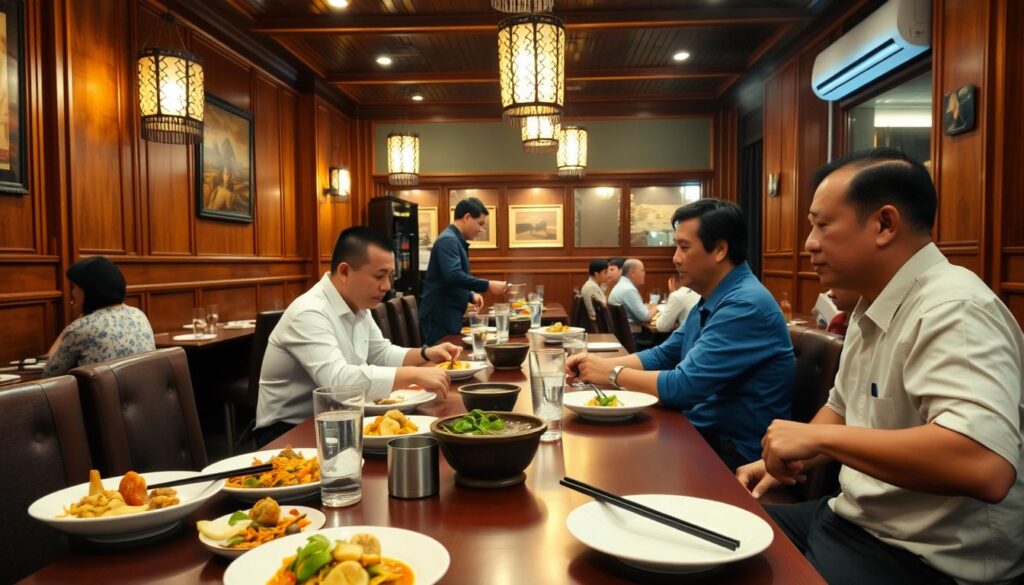
Conversational Norms
During meals, Thais tend to engage in light conversation. They often discuss everyday topics like food, family, or work. It’s customary to keep the conversation pleasant and avoid loud or boisterous talk, as this can be seen as impolite.
Engaging in polite conversation can make your dining experience more enjoyable. You can talk about the food, ask for recommendations, or discuss cultural differences.
Avoiding Controversial Topics
It’s advisable to steer clear of sensitive or controversial subjects, such as politics or religion. These can lead to discomfort or tension at the table. Instead, focus on positive and light-hearted topics that promote a harmonious atmosphere.
- Discuss the local cuisine and your favourite dishes.
- Ask your hosts or fellow diners about their day or weekend.
- Share stories about your travels or cultural experiences.
By being considerate of the conversation topics, you can contribute to a positive and respectful dining environment.
Understanding Thai Beverages
Thai beverages are a big part of dining out. They come in many types, from traditional drinks to alcohol. Knowing what to choose and how to order can make your meal better.
Thailand offers a wide range of traditional drinks that go well with its food. Here are some favorites:
- Thai Iced Tea: A sweet and creamy drink made with black tea, milk, and sugar.
- Singha Beer: A crisp and refreshing Thai beer that pairs well with spicy dishes.
- Fresh Coconut Water: A refreshing and hydrating drink perfect for hot days.
- Sangria: A fruity and flavorful drink that is popular in Thai restaurants.
Traditional Drinks to Pair with Your Meal
Choosing the right drink can make your meal even better. For instance, Thai Iced Tea is great with spicy dishes because it cools your tongue.
Here are some drinks and what they go well with:
- Tom Yum Soup pairs well with a refreshing Singha Beer.
- Green Curry can be paired with Thai Iced Tea for a balanced flavor.
- Fresh Spring Rolls are nicely complemented by a glass of Fresh Coconut Water.
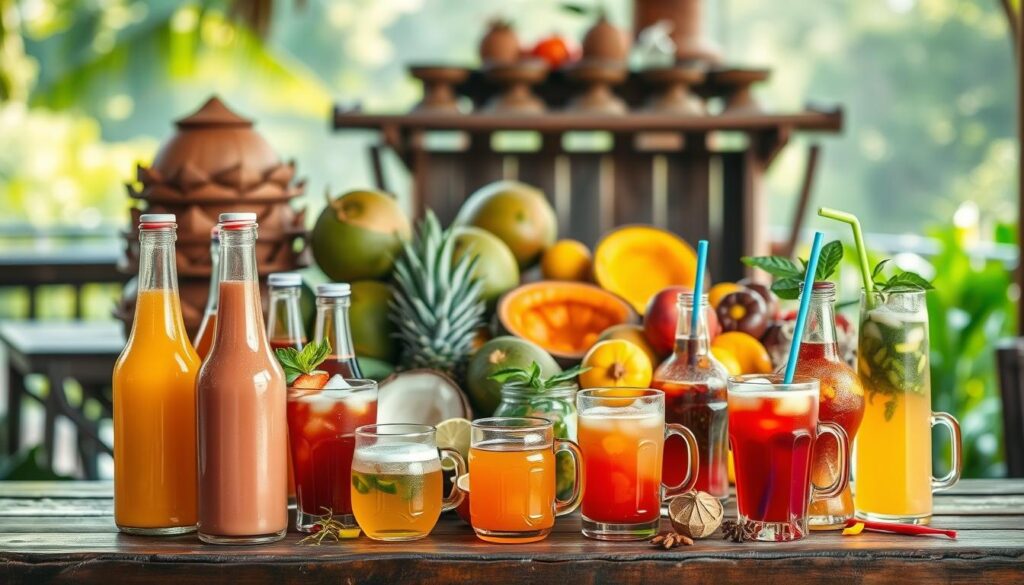
Alcohol Etiquette in Thailand
Knowing how to drink in Thailand is important to avoid causing offense. When drinking with locals, always pour drinks for others. This shows respect and friendship.
Here are some tips for drinking in Thailand:
- Always pour drinks for others before pouring your own.
- Be mindful of your drinking pace and try to keep up with the group.
- Avoid getting drunk, as this can be seen as impolite.
By following these tips, you can enjoy your meal more and make friends with the locals.
Tips for Dining Out in Thailand
Dining out in Thailand is a great way to try many authentic dishes. It’s important to know the local dining culture. This includes table manners in Thailand and how to dine traditionally.
Restaurant Selection
Choose restaurants that locals love. They usually serve fresh, authentic food. You can also ask your hotel or a local for the best places to eat.
Navigating Menus
Menus in Thailand might be in Thai, and dishes are often meant to be shared. If you’re unsure, ask your server for help. They can guide you on what to order and how to enjoy your meal.

